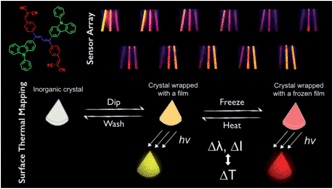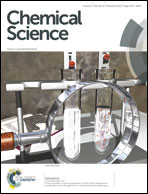3D cross-correlative matrix temperature detection and non-invasive thermal mapping based on a molecular probe†
Abstract
Cryogenic temperature detection underlies the understanding of important physical phenomena and is crucial for material science and space exploration. Simple, facile, and accurate assessment of temperature, especially for surface or body thermal mapping, is one of the challenges that must be addressed when developing new materials or technologies for thermometers. Here, we introduce a temperature detection strategy based on a 3D cross-correlative matrix derived from fluorescence response patterns of an organic probe in three solvation envelopes. The intermolecular interactions, such as excimer or exciplex formation, intramolecular charge transfer and solvent relaxation processes, between the probe and molecule surroundings, are attributed to the unique temperature-dependent optical behaviors in different solutions. The precise temperature detection originated from apparent variations in fluorescence intensity and wavelength upon temperature change in these solvents. This enabled the construction of a comprehensive temperature sensor array, which gives a unique visible color pattern of signals as a read-output discernible by the naked eye. Furthermore, as a proof-of-concept, a new strategy for facile and non-destructive thermal mapping of a crystal surface is presented.


 Please wait while we load your content...
Please wait while we load your content...